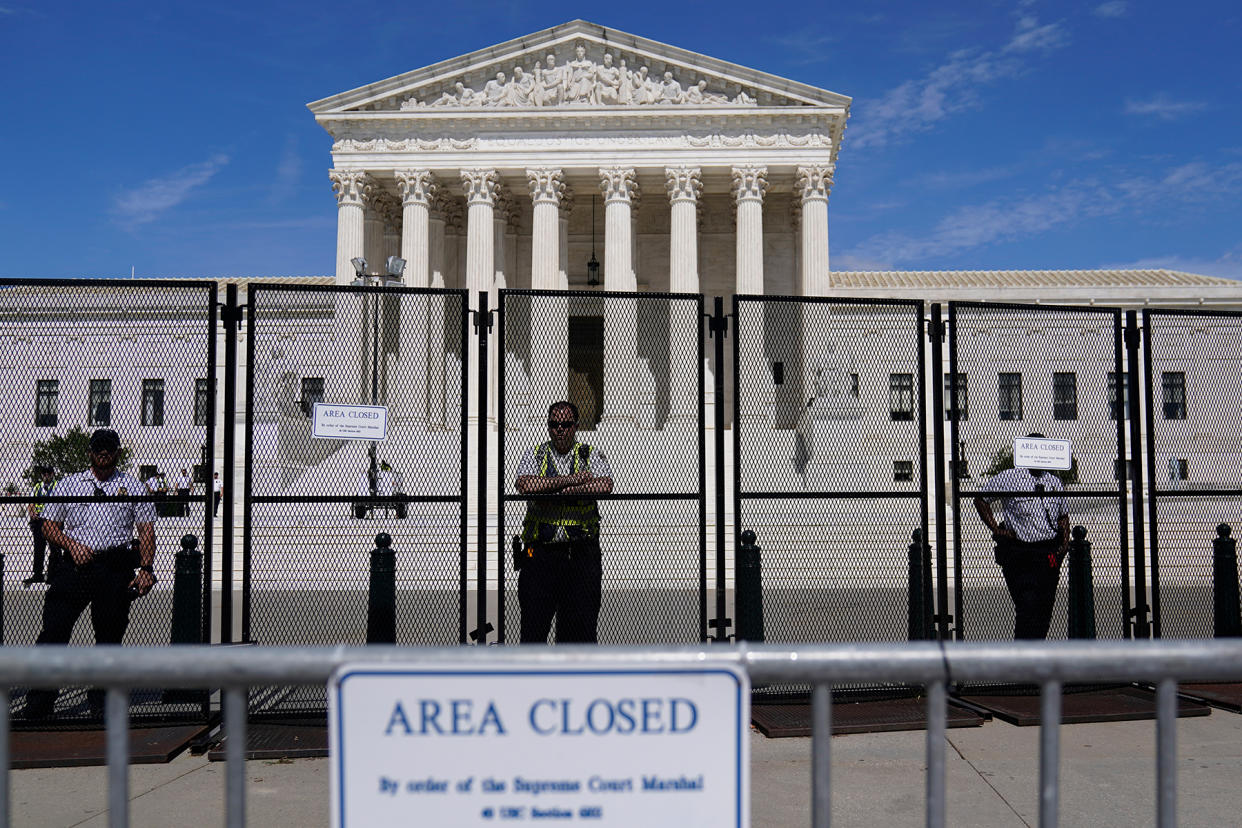SCOTUS Buffer Zone Covers Group Fighting Buffer Zones at Abortion Clinics

Soon after the draft of its decision stripping abortion rights got leaked, the Supreme Court resembled a fortress. The courthouse was ringed with eight-foot fencing and public streets and walkways near the grounds were closed to the public.
There was thick irony in the fact that the high court justices had created a “buffer zone” to limit pro-abortion demonstrators from getting up-close-and-personal. The court has spent decades declaring broad buffer zones around abortion clinics unconstitutional, forcing patients to run an intimidating (and often abusive) gauntlet of anti-abortion protesters.
More from Rolling Stone
She Made Planned Parenthood a Juggernaut. Now Her Progress Is Being Erased
The Supreme Court Isn't Done Carrying Water for Right-Wing Activists
Supreme Court to Rule on Whether Republican State Legislatures Can Rig Elections
This irony runs deeper still. The anti-abortion group Liberty Counsel jumpstarted the war on clinic buffer zones with a 1994 Supreme Court case, and continues to battle such restrictions as an intolerable infringement on First Amendment rights. The group has an outpost in Washington, D.C., but Americans cannot protest there either — because the Supreme Court buffer zone actually encompasses its building too.
Liberty Counsel maintains, under its umbrella, a D.C. ministry called Faith & Liberty, which sits in the shadow of the Supreme Court — across the street to the east. That street has been cordoned off with security checkpoints, and access has been limited to residents and workers on the block, keeping potential demonstrators far from the ministry, which is marked by giant stone tablets inscribed with the 10 Commandments.
Rolling Stone spoke to Patty Bills, Director of Constituency Affairs at Faith & Liberty, on Thursday. She blamed “evil” demonstrators for this state of affairs. “With all the protesters, and with Jane’s Revenge and ShutDownDC protesters, that’s when the large fencing went up,” she said. “And then it got worse because the protesting got worse.” Public access was also shut down to the “area where people come and go into the Supreme Court — for the security of everybody,” she added.
Bills underscored that her group didn’t seek the protection: “We just happened to be located in that same area. They didn’t even ask us.“ But with no apparent sense of irony, she added that she agrees with the spirit of the buffer zone. “I don’t want anyone harmed, hurt or threatened, which has happened even for our own staff,” she said of what she described as the violent and destructive aims of the protesters.
Regardless, both the Supreme Court and Liberty Counsel are now benefiting from the peace of mind they have worked to strip from Americans seeking abortions.
Liberty Counsel takes credit for bringing the 1994 case, Madsen v. Women’s Health Center, which led the Supreme Court to strike down a 300-foot buffer zone around abortion clinics in Florida. In another 2014 buffer zone case, McCullen v. Coakley, Liberty Counsel filed an amicus brief with the high court decrying a 35-foot buffer zone in Massachusetts as a “significant threat to bedrock First Amendment freedoms,” arguing that such zones “chill the very kind of controversial speech the Founders sought to protect.” The brief concluded: “It is critically important that citizens’ free speech rights not be sacrificed in order to protect others from having to encounter offensive or controversial speech.”
Chief Justice John Roberts, writing in a rare 9-0 decision, concurred that such “buffer zones impose serious burdens” on free speech by taking the “extreme step of closing a substantial portion of a traditional public forum to all speakers.”
That Supreme Court ruling gutted, but didn’t fully outlaw, buffer zones. And Liberty Counsel has kept fighting them, including seeking to reverse a buffer zone rule in Harrisburg, Pennsylvania, which it argues imposed a “gross intrusion” on constitutional rights and “an ideological ban on pro-life speech.”
Today, access to the public street behind the Supreme Court is restricted to residents and workers on the block. Families “have to go through a special security in order to show that they live there,” Bills says. “Even for us, we have to have a letter that shows that we belong to the ministry center. And we have to carry that letter all the time.”
The Supreme Court has fought in court to establish that it is entitled to maintain a buffer zone that encompasses the plaza directly in front of the courthouse. This limited buffer zone was blessed by the D.C. Court of Appeals in a 2015 ruling that the government interest in “preserving decorum” as well as in “assuring the appearance (and actuality) of a judiciary uninfluenced by public opinion” made this restriction on free speech reasonable — particularly given the public’s access to the sidewalk fronting the plaza.
But the Supreme Court’s press office did not respond to questions about how it justifies closing the public street and sidewalk behind the building. The move appears to contradict Justice Roberts’ 2014 buffer zone opinion touting “streets and sidewalks” as epitomizing “public fora” — meaning the “government’s ability to restrict speech in such locations is ‘very limited.’”
The constitutional protection for reproductive freedom that American women relied on for nearly 50 years disappeared in an instant with the Dobbs decision. Yet the same Supreme Court has now insulated itself — and a notorious friend of the court — from being exposed to in-your-face street protests by demonstrators shouting outrage and indignation over its weighty decision. It must be nice.
Best of Rolling Stone

